|
Update: February 16th, 2008

Photo Courtesy of Richard Hendrickson
This is the second in a series of historically documented projects. The content of this page
was compiled based on interviews with Terrell Kott who along with Cyril Durrenberger (both from
Texas) and with assistance from ACF personel, spent one week during 1988 at the ACF St Charles Missouri photo archive copying
photos and compiling other information. Thanks also to Richard Henderickson, Ed Hawkins and Tom Mix.
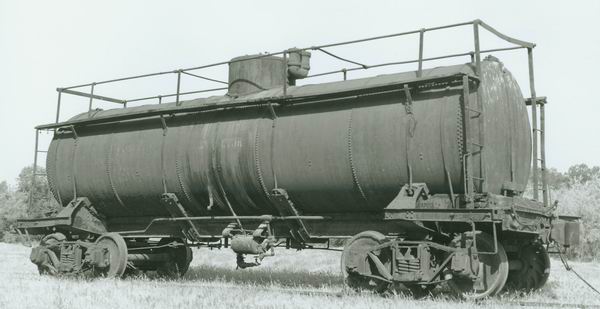 Photo Courtesy of Arn Menke
Photo Courtesy of Arn Menke
In 1906 ACF was granted a patent on a new type of tank anchor eliminating tank head blocks
found on earlier tank cars. (see above photo).This devise was first applied to the type 7 tank cars.
As part of ACFs practice, the type car was designated based on the year it was first built.
Type 7 cars were built between 1907 and 1912 in the ACF facility in Milton PA. The design of the type 7 car pertained to 6,000 /
8,000 and 10,000 gallon cars, as well as a few other size. All Type 7 cars shared a common under frame.Tank saddles were able
to accommodate different tank diameters with the aid of saddle wedges / wood blocks.258 different lots of these cars were built.
Lots ranged in size from 1 car to 100 cars.
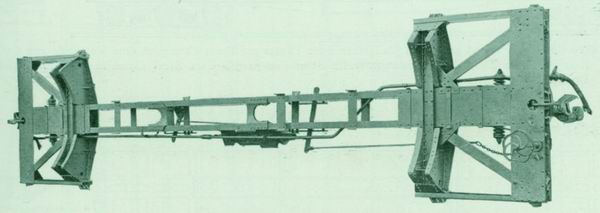
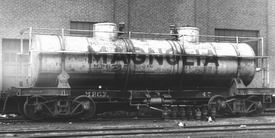 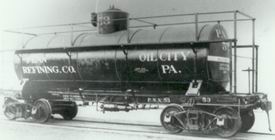
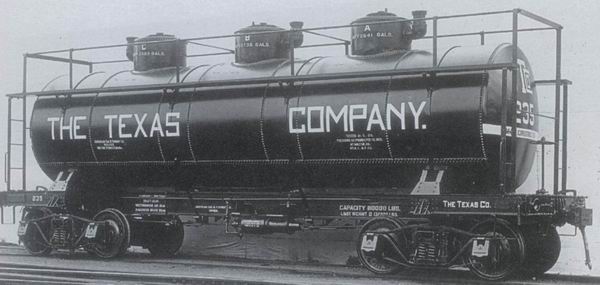
Both Railroads and private owners purchased type 7 cars. These cars commonly hauled oil and finished
product like Kerosene, Gasoline, tar, Asphalt, Cotton seed oil, Vegetable oils and corn syrup. Some cars were capable of carrying two or three different products and were easily spotted by the number of Domes.
 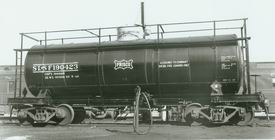
The single Dome 10,000 car was owned by several Railroads. Based on the April 1948 Equipment Register the following railroads had this type of car in revenue service.
Southern Pacific 39 in 1948 with 5 remaining on the roster in 1964. CB&Q 107 cars. Chicago and Northwestern 83 cars 1948, Western Pacific 55, Fort Worth & Denver 100 cars. The "Frisco" had 492 cars on their roster as of 1918.with 24 cars on roster in 1948.
Santa Fe RR owned 10-8,000 cars. The Great Western owned 12-8,000 cars. McCloud River Railroad owned 3-8,000 cars in 1948. The East Jersey Railroad and Terminal in Bayonne NJ owned a combination of 6 / 8 / and 10,000 gal cars per the 1948 equipment register. Diesel fuel, gasoline, lubricants and water, were common commodies carried by the railroads for their own use. They were also quite popular as auxilary water cars and could be found behind tenders.
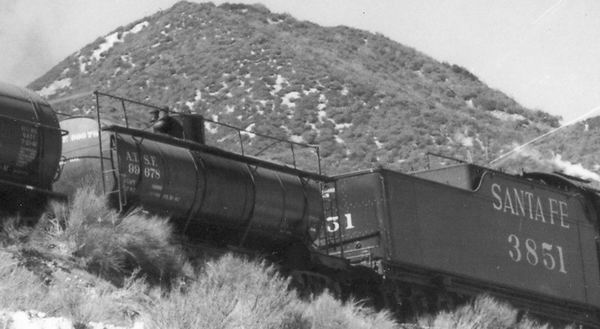
Photo Courtesy of Richard Hendrickson
Other railroads which purchased the cars were the Grand Trunk Western 50-8,000 single dome. MKT owned 3-6,000 single and 1-6,000 double dome.(These card disapeared off the roster before 1948).
San Diego and Arizona-2 10,000 single dome. Missouri Oklahoma and Gulf 44 cars (Size not specified) Beaver Dam Railroad of Damascus Virginia owned 8-6,000 gal double dome cars.
Delaware River and Union Railroad bought new,40-10,000 single dome cars.The railroad disapeared out of the equipment registers in the 20's. Was this a private Railroad owned by DuPont?
Oil companies were also major owners of this type car Texaco owned 503 cars a mix of 10,000 single 8,000 single double and triple and 6,000 single and double dome
using reporting marks "TCX" but managed by General American Transportation Corporation (GATX). Morrell Tank Lines, Union Tank Lines, Sherwin Williams, all owned 8,000 single dome cars.
Barber Asphalt Co owned 180 8,000 single.Magnolia Petroleum owned 100 8,000 single and double dome and 130 of the 10,000 gal Single dome cars.
Kanotex Refining CO owned 10,000 single dome. Trinity Cotton Oil owned 27 cars 8,000 single dome. There were many other compaines that bought the cars new or leased cars thru leasing companies.
Please note some railroads and private owners were very lax in reporting size of the cars and down grading to "MOW" service.
Prototype History
Project Update
10,000 Gallon Pilot Models
10,000 Gallon Reservation Page
8,000 Gallon Pilot Models
8,000 Gallon Reservation Page
6,000 Gallon Reservation Page |













